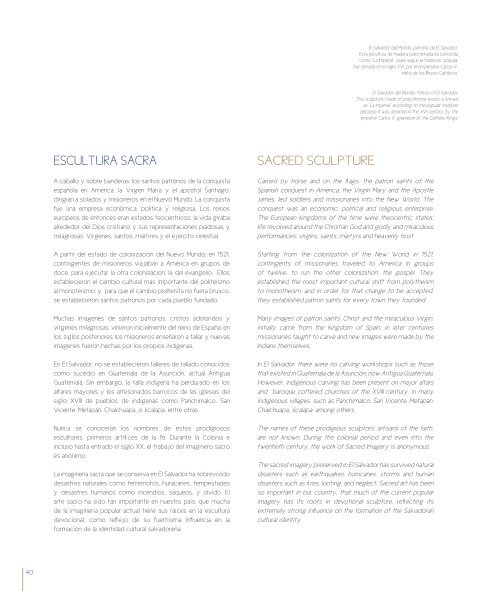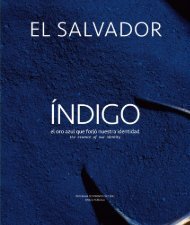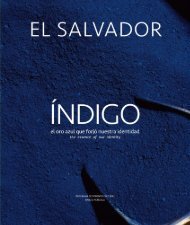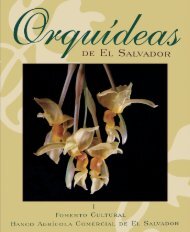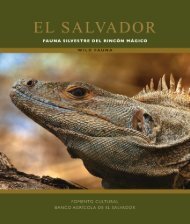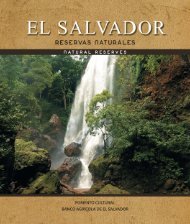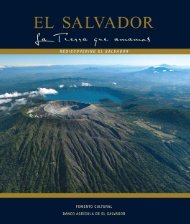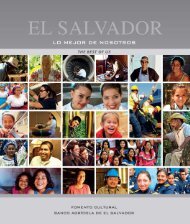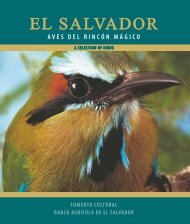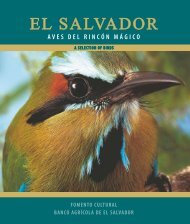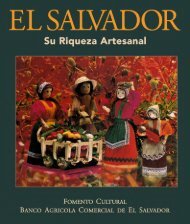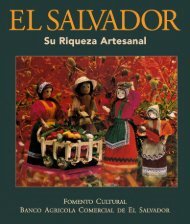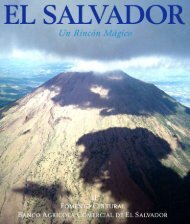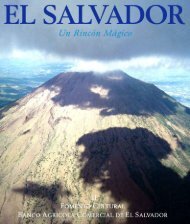Monumentos y Esculturas del Rincón Mágico
You also want an ePaper? Increase the reach of your titles
YUMPU automatically turns print PDFs into web optimized ePapers that Google loves.
El Salvador <strong>del</strong> Mundo, patrono de El Salvador.<br />
Esta escultura de madera policromada es conocida<br />
como “La Imperial”, pues según la tradición popular<br />
fue donada en el siglo XVI, por el emperador Carlos V,<br />
nieto de los Reyes Católicos.<br />
El Salvador <strong>del</strong> Mundo, Patron of El Salvador.<br />
This sculpture; made of polychrome wood, is known<br />
as “La Imperial” according to the popular tradition<br />
because it was donated in the XVI century, by the<br />
emperor Carlos V, grandson of the Catholic Kings.<br />
ESCULTURA SACRA<br />
A caballo y sobre banderas, los santos patronos de la conquista<br />
española en América, la Virgen María y el apóstol Santiago,<br />
dirigían a solados y misioneros en el Nuevo Mundo. La conquista<br />
fue una empresa económica, política y religiosa. Los reinos<br />
europeos de entonces eran estados teocéntricos: la vida giraba<br />
alrededor <strong>del</strong> Dios cristiano y sus representaciones piadosas y<br />
milagrosas: Vírgenes, santos, mártires y el ejército celestial.<br />
A partir <strong>del</strong> estado de colonización <strong>del</strong> Nuevo Mundo, en 1521,<br />
contingentes de misioneros viajaban a América en grupos de<br />
doce, para ejecutar la otra colonización: la <strong>del</strong> evangelio. Ellos<br />
establecieron el cambio cultural más importante <strong>del</strong> politeísmo<br />
al monoteísmo; y para que el cambio politeísta no fuera brusco,<br />
se establecieron santos patronos por cada pueblo fundado.<br />
Muchas imágenes de santos patronos, cristos adoloridos y<br />
vírgenes milagrosas, vinieron inicialmente <strong>del</strong> reino de España; en<br />
los siglos posteriores los misioneros enseñaron a tallar y nuevas<br />
imágenes fueron hechas por los propios indígenas.<br />
En El Salvador, no se establecieron talleres de tallado conocidos<br />
como sucedió en Guatemala de la Asunción, actual Antigua<br />
Guatemala. Sin embargo, la talla indígena ha perdurado en los<br />
altares mayores y los artesonados barrocos de las iglesias <strong>del</strong><br />
siglo XVIII de pueblos de indigenas como Panchimalco, San<br />
Vicente, Metapán, Chalchuapa, o Jicalapa, entre otras.<br />
Nunca se conoceran los nombres de estos prodigiosos<br />
escultores, primeros artífices de la fe. Durante la Colonia e<br />
incluso hasta entrado el siglo XX, el trabajo <strong>del</strong> imaginero sacro<br />
es anónimo.<br />
La imaginería sacra que se conserva en El Salvador ha sobrevivido<br />
desastres naturales como terremotos, huracanes, tempestades<br />
y desastres humanos como incendios, saqueos, y olvido. El<br />
arte sacro ha sido tan importante en nuestro país, que mucha<br />
de la imaginería popular actual tiene sus raíces en la escultura<br />
devocional, como reflejo de su fuertísima influencia en la<br />
formación de la identidad cultural salvadoreña.<br />
SACRED SCULPTURE<br />
Carried by horse and on the flags, the patron saints of the<br />
Spanish conquest in America, the Virgin Mary and the Apostle<br />
James, led soldiers and missionaries into the New World. The<br />
conquest was an economic, political and religious enterprise.<br />
The European kingdoms of the time were theocentric states:<br />
life revolved around the Christian God and godly and miraculous<br />
performances: virgins, saints, martyrs and heavenly host.<br />
Starting from the colonization of the New World in 1521,<br />
contingents of missionaries traveled to America in groups<br />
of twelve, to run the other colonization: the gospel. They<br />
established the most important cultural shift from polytheism<br />
to monotheism, and in order for that change to be accepted,<br />
they established patron saints for every town they founded.<br />
Many images of patron saints, Christ and the miraculous Virgin,<br />
initially came from the kingdom of Spain; in later centuries<br />
missionaries taught to carve and new images were made by the<br />
Indians themselves.<br />
In El Salvador, there were no carving workshops such as those<br />
that existed in Guatemala de la Asunción, now Antigua Guatemala.<br />
However, indigenous carving has been present on major altars<br />
and baroque coffered churches of the XVIII century, in many<br />
indigenous villages, such as Panchimalco, San Vicente, Metapán,<br />
Chalchuapa, Jicalapa, among others.<br />
The names of these prodigious sculptors, artisans of the faith,<br />
are not known. During the colonial period and even into the<br />
twentieth century, the work of Sacred Imagery is anonymous.<br />
The sacred imagery preserved in El Salvador has survived natural<br />
disasters such as earthquakes, hurricanes, storms and human<br />
disasters such as fires, looting, and neglect. Sacred art has been<br />
so important in our country, that much of the current popular<br />
imagery has its roots in devotional sculpture, reflecting its<br />
extremely strong influence on the formation of the Salvadoran<br />
cultural identity.<br />
40


